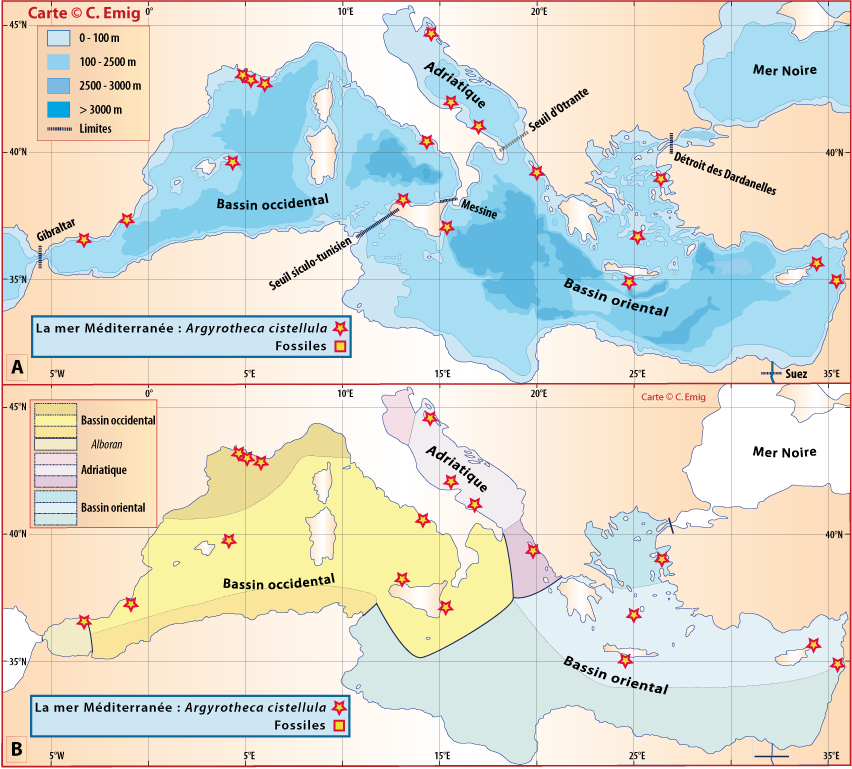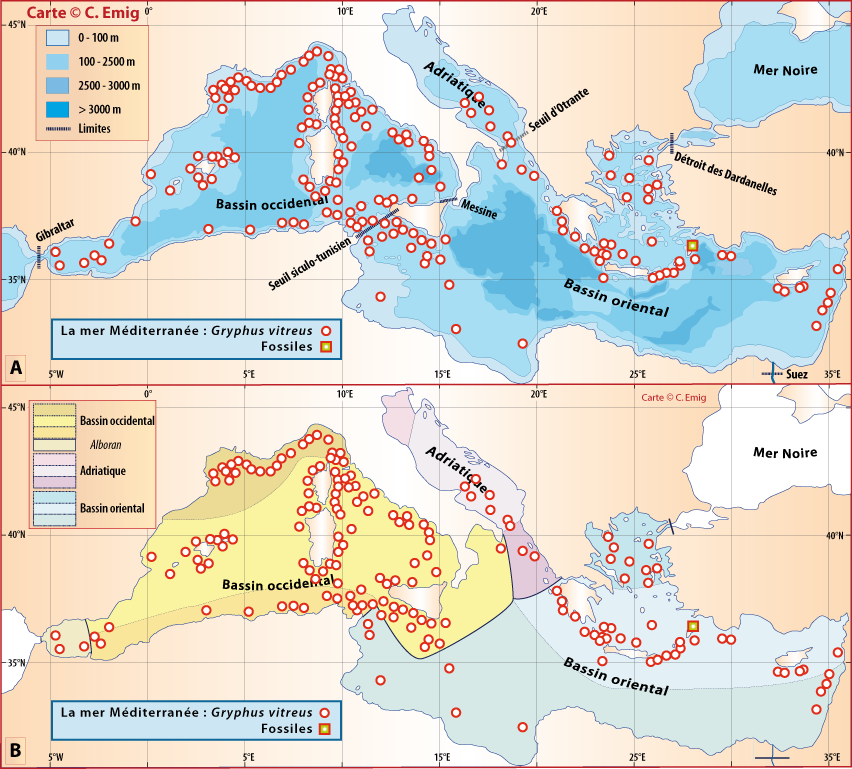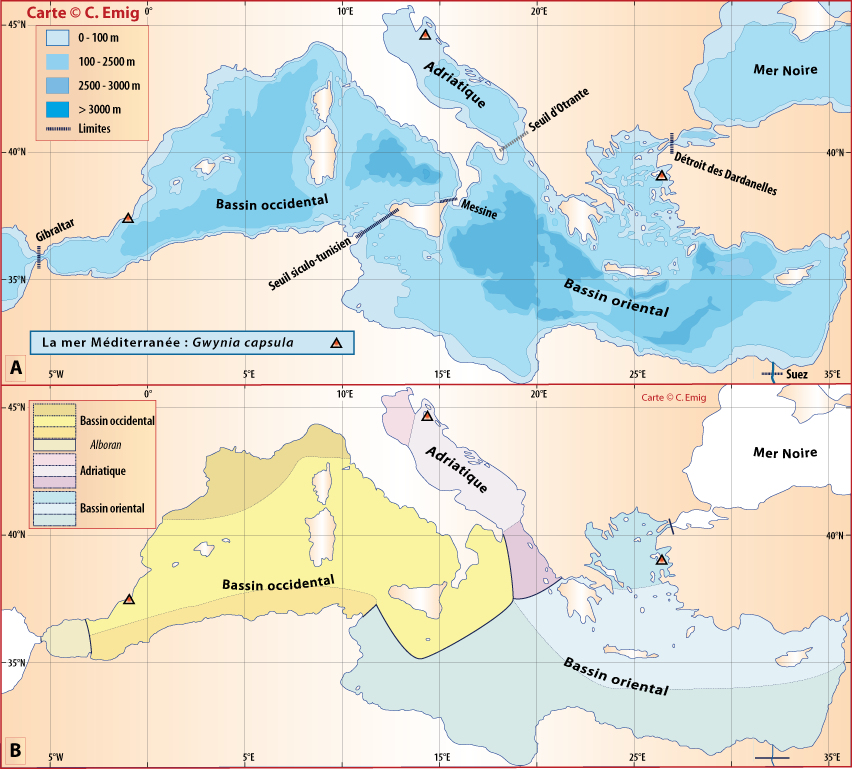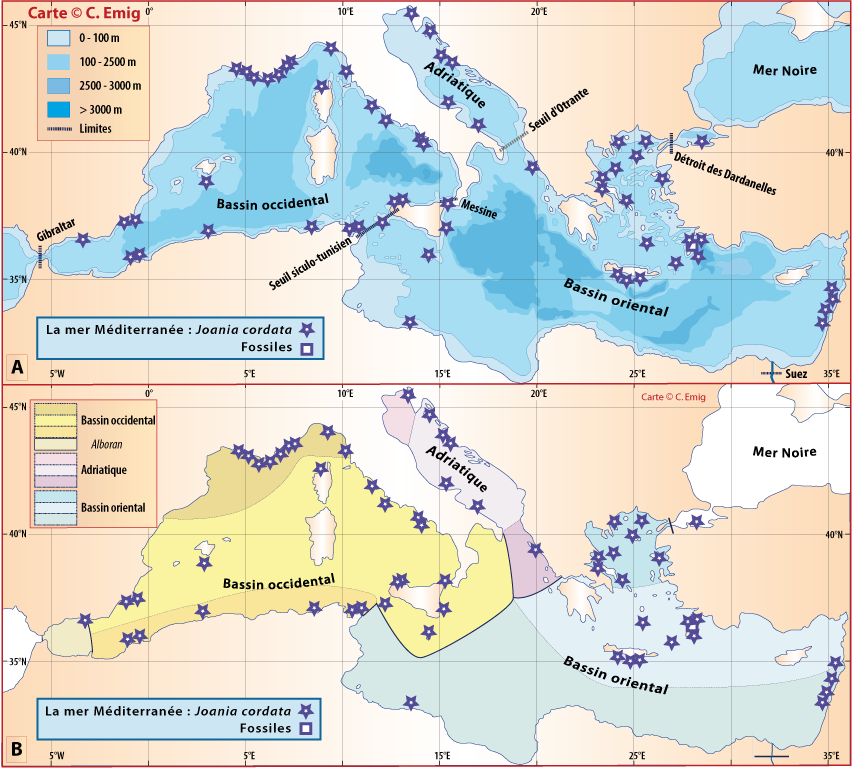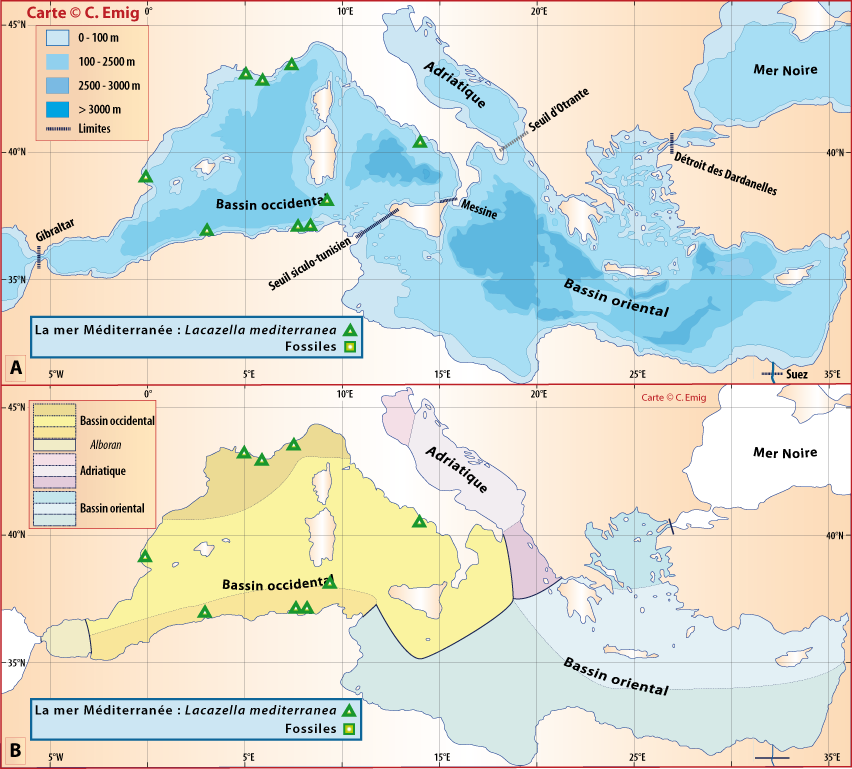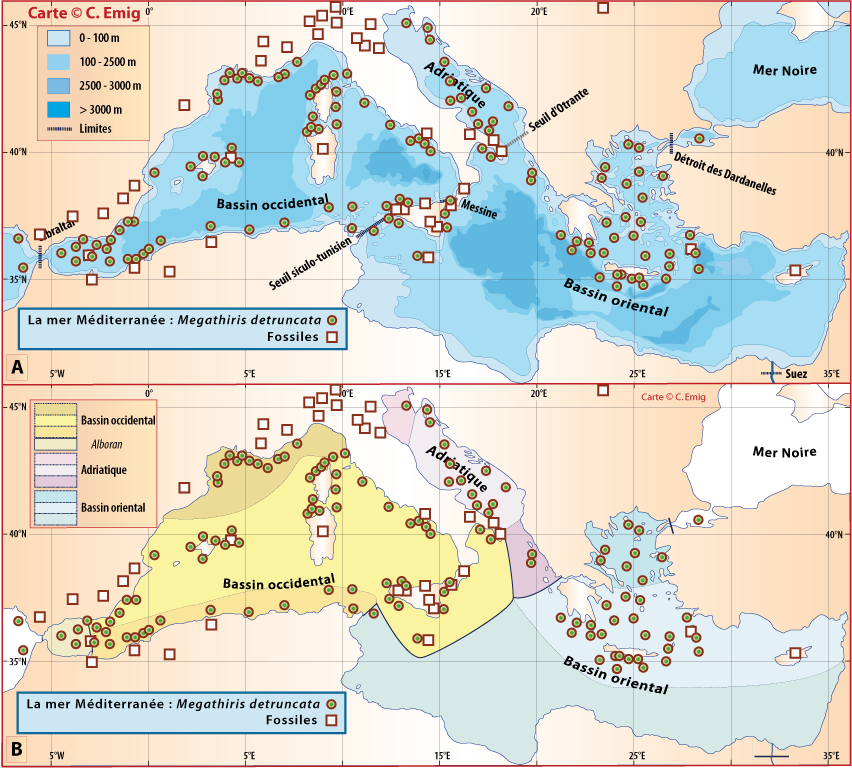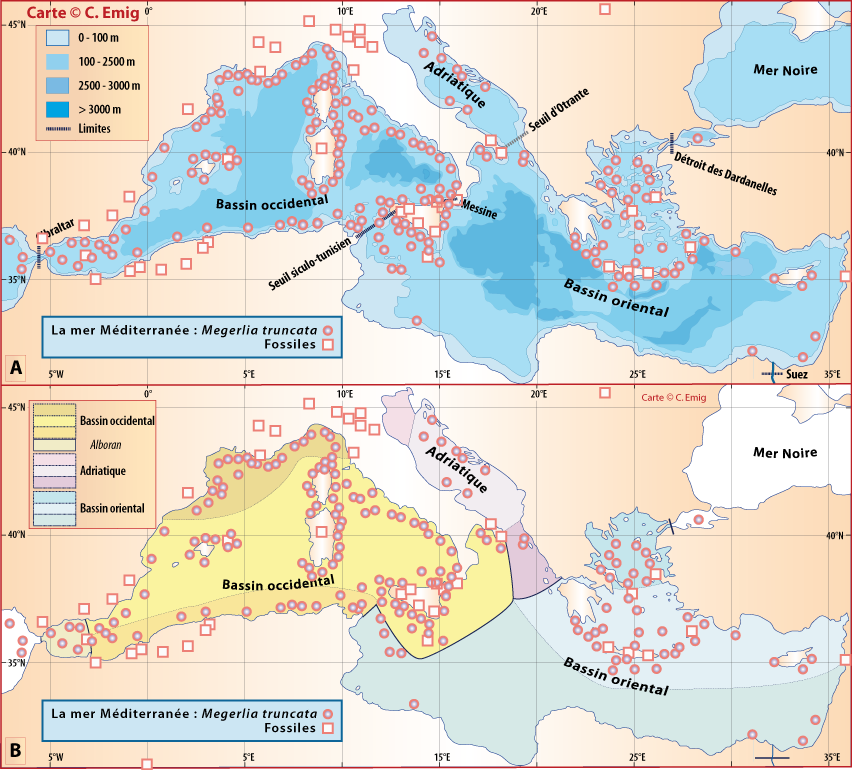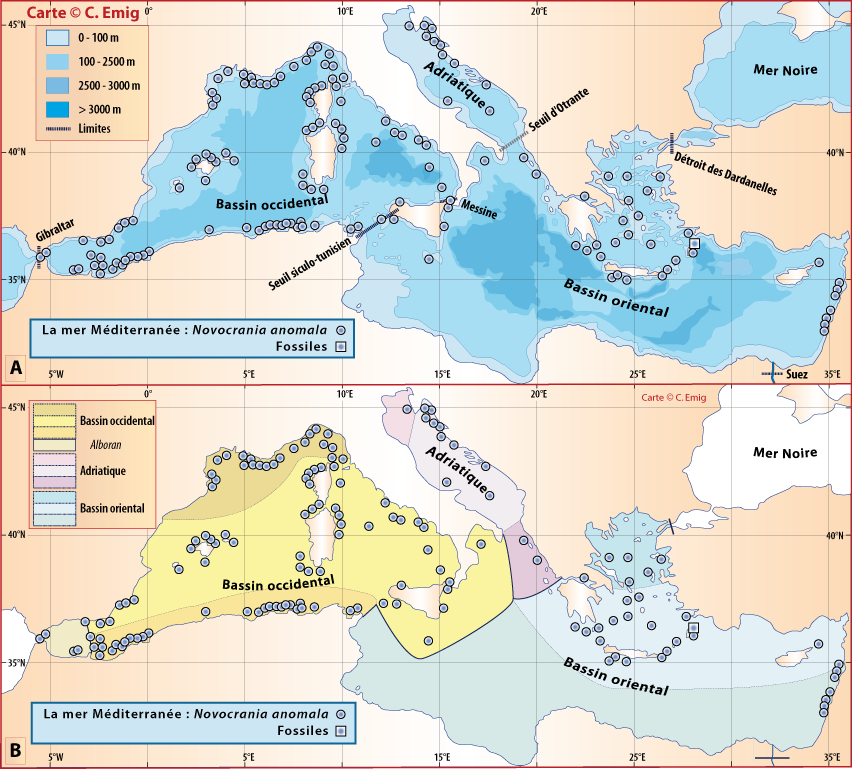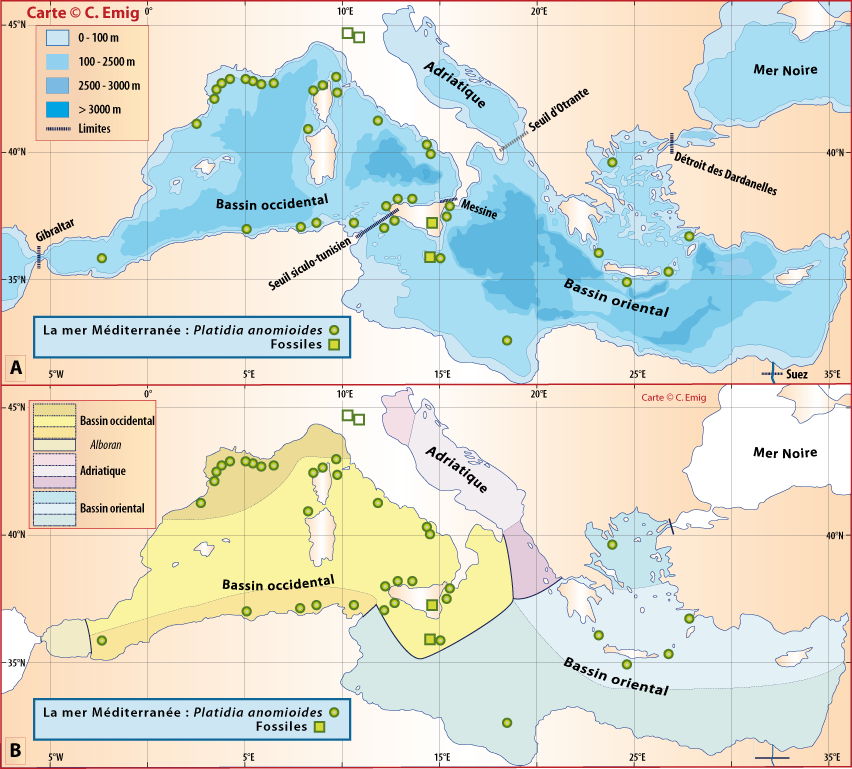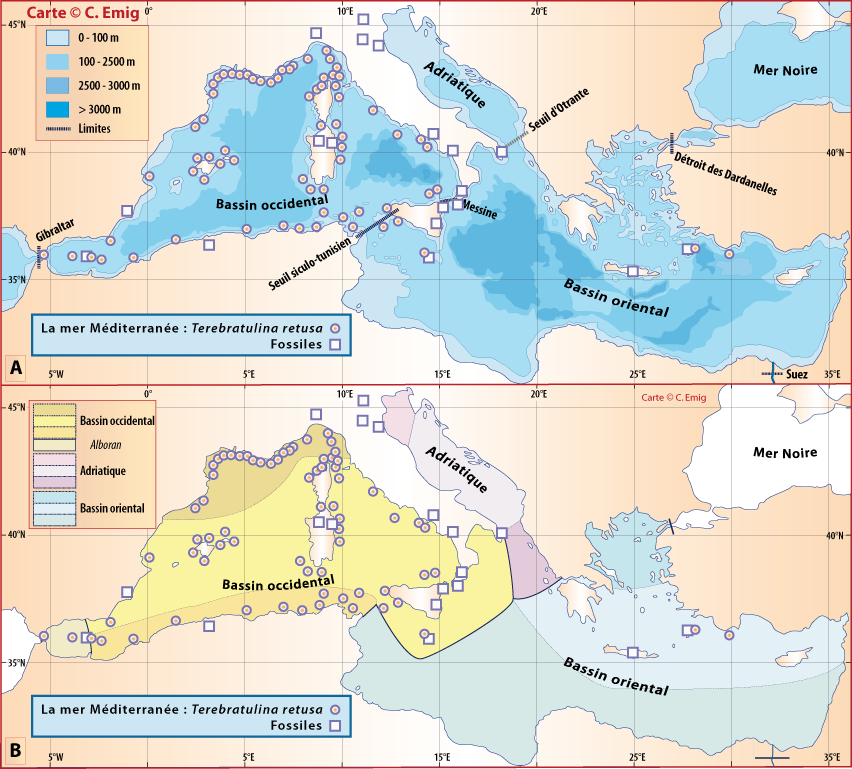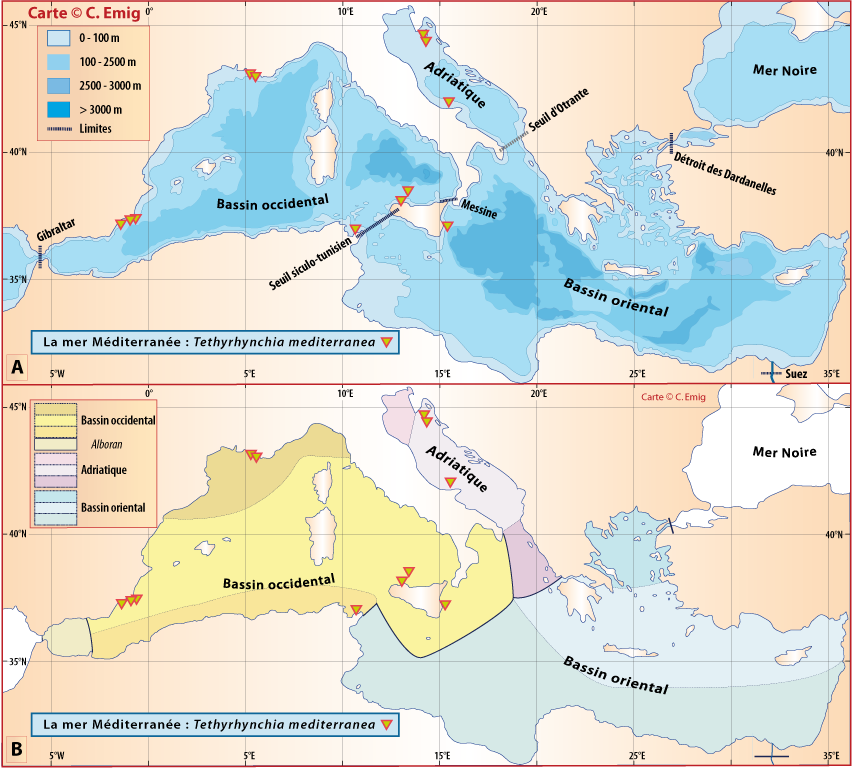Introduction
Brachiopods, commonly known as lamp-shells, are lophophorate animals found only in marine waters. They are bilaterally symmetrical solitary coelomates, sessile benthic suspension-feeders, enclosed in a shell formed by a dorsal and a ventral valve, and fixed to or into the substrate by a pedicle. However, some taxa lacking a functional pedicle are cemented to the substratum by one of their valves, i.e., Novocrania. Brachiopods range in size from a few millimetres to over eight centimetres. The pedicle can adjust the position of the organism in relation to its surroundings (see Richardson, 1997; Emig, 1997). The lophophore, usually supported by a brachidium, varies in complexity among the taxa. Larvae are either planktotrophic or non-planktotrophic.
Classification
Phylum Brachiopoda Duméril, 1805
Subphylum CRANIIFORMEA Popov, Basset,Holmer & Laurie, 1993
Class Craniata Williams, Carlson, Brunton, Holmer & Popov, 1996
Order CRANIIDA Waagen, 1885
Superfamily Cranioidea Menke, 1828
Family CRANIIDAE Menke, 1828
Novocrania Lee & Brunton, 2001
Novocrania anomala (Müller, 1776) - type species
Subphylum RHYNCHONELLIFORMEA Williams, Carlson, Brunton, Holmer & Popov, 1996
Class Rhynchonellata Williams, Carlson, Brunton, Holmer & Popov, 1996
Order RHYNCHONELLIDA Kuhn, 1949
Superfamily Norelloidea Ager, 1959
Family TETHYRHYNCHIIDAE Logan 1994, in Logan & Zibrowius (1994)
Tethyrhynchia Logan 1994, in Logan & Zibrowius (1994)
Tethyrhynchia mediterranea Logan 1994, in Logan & Zibrowius (1994) - type species
Order THECIDEIDA Elliot, 1958
Superfamily Thecideoidea Gray, 1840
Family THECIDEIDAE Gray, 1840
Subfamily Lacazellinae Backhaus, 1959
Lacazella Munier-Chalmas, 1880
Lacazella mediterranea (Risso, 1826) - type species
Order TEREBRATULIDA Waagen, 1883
Suborder Terebratulidina Waagen, 1883
Superfamily Terebratuloidea Gray, 1840
Family TEREBRATULIDAE Gray, 1840
Subfamily Gryphinae Sahni, 1929
Gryphus Megerle von Mühlfeld, 1811
Gryphus vitreus (Born, 1778) - type species
Superfamily Cancellothyroidea Thomson, 1926
Family CANCELLOTHYRIDIDAE Thomson, 1926
Subfamily Cancellothyridinae Thomson, 1926
Terebratulina d'Orbigny, 1847
Terebratulina retusa (Linné, 1758) - type species
SubOrder Terebratellidina Muir-Wood, 1955
Superfamily Megathyridoidea Dall, 1870
Family MEGATHYRIDIDAE Dall, 1870
Megathiris d'Orbigny, 1847
Megathiris detruncata (Gmelin, 1791) - type species
Argyrotheca Dall, 1900
Argyrotheca cuneata (Risso, 1826) - type species
Argyrotheca cistellula (Wood, 1841)
Joania Álvarez, Brunton et Long, 2008
Joania cordata (Risso, 1826) - type species
Superfamily Platidioidea Thomson, 1927
Family PLATIDIIDAE Thomson, 1927
Subfamily Platidiinae Thomson, 1927
Platidia Costa, 1852
Platidia anomioides (Scacchi & Philippi, 1844) - type species
Superfamily Kraussinoidea Dall, 1870
Family KRAUSSINIDAE Dall, 1870
Subfamily Megerliinae Hiller, Mackinnon et Nielsen, 2008
Megerlia King, 1850
Megerlia truncata (Linné, 1767) - type species
SubOrder Uncertain
Superfamily Gwynioidea MacKinnon, 2006
Gwynia King, 1859
Gwynia capsula (Jeffreys,1859) - type species
Species list (genera in alphabetical order)
Genus Argyrotheca Dall, 1900 - |
[Type species= Terebratula cuneata Risso, 1826, p. 388 ]
Diagnosis from volume 5 of the Treatise on Invertebrate Paleontology (Kaesler, 2000):
- Small, commonly transversely ovate with wide hinge line but outline variable; ventribiconvex, smooth to more commonly multiplicate; beak short, subtruncate; foramen large, commonly hypothyrid; deltidial plates narrow. Pedicle collar well developed, supported by long, narrow, median septum. Cardinal process short, transversely elongate, buttressed by long, high, thick median septum; crura widely separate, short, prominent, pointed; loop long, formed of 2 slender, arcuate descending branches attached to base of crura, valve floor, and anterior end of median septum; short septal flanges present in adult stages; lophophore large, schizolophous, spicules not observed.
Geological range: Upper Cretaceous (Maastrichtian) - Present.
Terebratula cuneata Risso, 1826 p. 388
Terebratula soldaniana Risso, 1826
Anomia pera Mülhfeld, 1829
Terebratula pera Küster (1843)
Orthis pera Philippi (1844), Costa (1851)
Argiope cuneata (Risso): Davidson, 1852, 1886 ; Jeffreys, 1878
Cistella cuneata Gray (1853)
Argiope pera Brusina, 1866
Argyrotheca cuneata (Risso): Dall, 1920
Argiope barroisi Schulgin, 1885 p. 122: Emig (2020)
Type locality: "régions coralligènes" - off Nizza.
Depth range: 5 - 645 m. Mediterranean: Fig. x - present.
Bibliographic references on Argyrotheca ![]() (including the list above)
(including the list above)
Terebratula cistellula Wood, 1841, p. 253
Megathiris cistellula Forbes et Hanley, 1853, p. 361
Cistella cistellula Gray (1853)
Argiope cistellula Wood, 1874
Argiope cistellula: Jeffreys (1878)
Type locality: "Coralline Crag of Sutton, near Woodbridge in Suffolk" - Pliocene.
Depth range: 1-236 m. Mediterranean: Fig. x - present.
Bibliographic references on Argyrotheca ![]() (including the list above)
(including the list above)
Genus Gryphus Megerle von Mühlfeld, 1811 - |
[Type species = Anomia vitrea (Born, 1778) p. 104]
[non Gryphus Brisson, 1760, nom. null. (see DALL, 1920, p. 310); =Liothyrina Œhlert, 1887b, p. 1,316, obj. (see Thomson, 1927, p. 193); nom. nov. pro Liothyris Douvillé, 1879, p. 265, non Conrad, 1875]
Diagnosis from volume 4 of the Treatise on Invertebrate Paleontology (Kaesler, 2000):
- Elongate oval in outline; ventribiconvex; foramen small to medium, epithyrid; symphytium partially visible; pedicle collar short; cardinal process small, slightly concave, variable; outer hinge plates slightly con- cave, narrowly triangular; crural bases narrow and flush with inner margin of outer hinge plates; crural processes scooplike in side view; loop short, about 0.25 valve length, variable; descending branches slightly diverging; transverse band broad, gently arched.
Geological range: Eocene - Present.
Anomia vitrea (Born, 1778) p. 104
Terebratula vitrea var. minor Philippi, 1836, p. 99
Terebratula vitrea: Jeffreys, 1878, p. 403
Liothyris vitrea: Davidson, 1886, p. 6
Liothyrina vitrea: Fischer & Œhlert, 1891, p. 51
Gryphus vitreus : Dall, 1920, p. 311 (includes varieties elongatus Jeffreys and dilatatus Jeffreys)
Eurysina minor: Cooper, 1983, p. 259
Type locality: Port-Mahon, Menorca (Balearic Islands, Spain).
Depth range: 78 - 2678 m. Mediterranean: Fig. x - since Miocene.
Bibliographic references on Gryphus ![]() (including the list above)
(including the list above)
Genus Gwynia King, 1859 |
[Type species = Terebratula capsula Jeffreys, 1859, p. 43]
Diagnosis from volume 5 of the Treatise on Invertebrate Paleontology (Kaesler, 2000):
- Biconvex, notothyrium triangular, wider and larger than delthyrium. Ventral interarea narrow, triangular, apsacline; delthyrium bounded by 2 small, oval teeth. Dorsal valve interior with a pair of well-developed, arcuate, submarginal ridges extending from stout inner socket ridges; dorsal interarea anacline; cardinal process not differentiated.
Geological range: Pleistocene - Present.
Gwynia capsula (Jeffreys,1859) |
Type locality: Gwynia was described by King (1859) from a specimen collected by Jeffreys at Etretat (Normandy, France), while G. capsula was described by Jeffreys (1859) from a collection recorded in Belfast Lough, name of Belfast Bay (Ireland).
Depth range: 10-46 m. Mediterranean: Fig. x - present.
Bibliographic references on Gwynia ![]() (including the list above)
(including the list above)
|
Genus Joania Alvarez, Brunton & Long, 2008 - |
[Type-species = Terebratula cordata Risso, 1826 p. 389]
Diagnosis from Alvarez et al. (2008):
- Megathiridid genus with relatively small adult size, outline varying from elongate heart-shaped to rounded subrectangular, with narrow hinge, profile biconvex to ventribiconvex; externally two to four rounded and weakly defined ribs; dorsal interior with strong trifid, short-shafted cardinal process; median septum with tuberculate antero-ventral edge; radial ridges with well defined tubercles submarginally, anterior to weakly defined descending lamellae of brachidium, raised only posteriorly and at edges of median septum.
Geological range: Eocene - Present.
Terebratula neapolitana Scacchi, 1833
Orthis neapolitana (Scacchi): Philippi (1844)
Argiope neapolitana (Scacchi): Davidson (1852)
Argiope Forbesii (Scacchi): Davidson (1852)
Terabratula (Argiope) neapolitana (Scacchi) : Reeve (1861)
Argiope biplicata Seguenza, 1876
Argiope kowalevskii Schulgin, 1885
Cistella neapolitana (Scacchi) : Davidson (1887)
Argyrotheca cordata (Risso): Dall (1920)
Joania cordata Alvarez, Brunton & Long, 2008
Type locality: off Nizza, Mediterranean coast.
Depth range: 3 - 600 m. Mediterranean: Fig. x - present.
Bibliographic references on Joania ![]() (including the list above)
(including the list above)
Genus Lacazella Munier-Chalmas, 1880 - |
[Type-species = Thecidea mediterranea Risso, 1826, p. 394]
Diagnosis from volume 5 of the Treatise on Invertebrate Paleontology (Kaesler, 2006):
- Relatively small, irregular with convex pseudodeltidium; interior of ventral valve papillose to spinose except over muscle scars, hemispondylium projecting anteriorly as two spurs; dorsal valve with hypercline interarea, bridge with marsupial notch, median septum divided to form trifurcating structure consisting of pair of lateral ramuli and posterior median ridge uniting with jugal pillar, dorsal lobes interdigitating with ramuli; shell granular except for superficial traces of fibrous secondary shell on dorsal surface of teeth; mantle thin, coarsely spicular.
Geological range: Late Paleocene - Present.
Thecidea mediterranea Risso, 1826, p. 394
Thecidea spondylea Scacchi, 1836
Terebratula (Thecidea) mediterranea (Risso): Reeve, 1861
Thecidium mediterraneum (Risso): Lacaze-Duthiers, 1861
Type locality: off coast of Nice (France).
Depth range: 1 - 110 m. Mediterranean: Fig. x - present.
Bibliographic references on Lacazella ![]() (including the list above)
(including the list above)
Genus Megathiris d'Orbigny, 1847 - |
[Megathiris d'Orbigny, 1847, p. 269, nom. nov. pro Argiope Deslongchamps, 1842, p. ix, non Audouin in Savigny, 1827] [*Anomia detruncata Gmelin, 1791, p. 3347] [=Megathyris Bronn, 1848, p. 244; Argyope Davidson, 1850, p. 65, non Savigny, 1826].
[Type-species = Anomia detruncata Gmelin, 1791 p. 3347]
Diagnosis from volume 5 of the Treatise on Invertebrate Paleontology (Kaesler, 2006):
- Small, broadly transverse, hinge line straight; ventribiconvex, multiplicate, anterior commissure rectimarginate to slightly uniplicate; beak short, attrite; foramen hypothyrid, deltidial plates disjunct. Hinge teeth small, elongate; pedicle collar supported by long, narrow median septum and 2 subdued lateral septa extending almost to anterior margin. Cardinal process small, transverse, grooved; cardinalia with low hinge platform uniting 2 prominent socket ridges; crura short, widely separated, crural processes prominent, horizontal, pointed; median septum very long, narrow, high; flanked in anterior part of shell by 2 lateral septa reaching to near middle of dorsal valve; loop of 2 slender, arcuate descending branches free only near crura, attached to base of crura, valve floor, and anterior extremities of lateral septa and median septum; lophophore attached to dorsal mantle, ptycholophous; rarely weakly spiculate.
Geological range: Upper Cretaceous (Campanian) - Present.
Anomia decollata Chemnitz, 1785
Terebratula urna antiqua Risso, 1826
Terebratula cardita Risso, 1826
Terebratula aperta Blainville, 1828
Terebratula dimidiata Scacchi, 1833
Argiope detruncata (Gmelin): Eudes-Deslongchamps (1842)
Orthis detruncata (Gmelin): Philippi (1844)
Megathiris detruncata (Gmelin): d'Orbigny (1847)
Terebratula pectiniformis Costa, 1851
Argiope decollata: Jeffreys (1878) ; Davidson (1887)
Type locality: "Habitat in mari mediterraneo, coralliis adhaerens".
Depth range: 5 - 896 m. Mediterranean: Fig. x - since Eocene.
Bibliographic references on Megathiris ![]() (including the list above)
(including the list above)
Genus Megerlia King, 1850 - |
[= Mühlfeldtia Bayle, 1880; Pantelleria Dall, 1919 (type Terebratula monstruosa Sacchi, 1836)]
[Type species= Anomia truncata Linné, 1767 (p. 1152)]
Diagnosis from volume 5 of the Treatise on Invertebrate Paleontology (Kaesler, 2006):
- Medium size, usually wider than long, biconvex to concavoconvex; anterior commissure unisulcate; capillate, striae slightly nodulose; foramen large, submesothyrid to amphithyrid; beak suberect, subtruncate, usually abraded; deltidial plates disjunct. Valve interiors radially tuberculate; ventral valve with small median septum extending under but not supporting pedicle collar. No cardinal process; crural bases attached to inner sides of widely divergent socket ridges that are excavate below; loop bifurcate with distal extensions forming complete ring, descending branches extending from cardinalia to ring.
Lophophore plectolophous; spicules common in mantle and arms.
Geological range: Miocene - Present.
Anomia truncata Linné, 1767
Criopoderma truncatum (Linné, 1767)
Terebratula monstruosa Sacchi, 1836
Orthis truncata var. Philippi, 1836
Megerlia gigantea (Deshayes, 1863)
Megerlia echinata (Fischer & Œlhert, 1890)
Pantellaria monstruosa Dall, 1919
Muhlfeldtia disculus (Dall, 1920)
Megerlia echinata (Fischer & Œlhert, 1890)
Type locality: "Habitat in Pelago Norvegico supra corallia."
Depth range: 8 - 1086 m. Mediterranean: Fig. x - since Miocene.
Bibliographic references on Megerlia ![]() (including the list above)
(including the list above)
Genus Novocrania Lee et Brunton, 2001 - |
[Type species= Patella anomala Müller, 1776; ICZN plenary powers, 1988, opinion 1468]
Diagnosis from volume 2 of the Treatise on Invertebrate Paleontology (Kaesler, 2000):
- Dorsal valve convex to conical; beak subcentral to posterocentral, smooth, finely pustulose or rarely finely costellate; posterior margin commonly straight; recent species with dendroid shell punctation; dorsal posterior adductor scars large, rounded, thickened, widely separated; anterior scars commonly crescentic, raised above valve floor; weak myophragm bisects muscle field; encrusting; ventral valve uncalcified in recent species, otherwise sometimes thin; ventral posterior adductor scars large, anterior scars united medially; marginal mantle setae observed in recent forms; valve margins variably thickened, with limbus or faint submarginal rim.
Geological range: Paleogene (Eocene) - Present.
Type locality: Hår-Krøllen (Denmark).
Depth range: some meters to 1665 m. Mediterranean: Fig. x - since Oligocene.
Bibliographic references on Novocrania ![]() (including the list above)
(including the list above)
Genus Platidia Costa, 1852 - |
[Type species= Orthis anomioides Scacchi & Philippi, 1844 in Philippi, 1844 (p. 69)]
Synonyms : Morrisia Davidson, 1852, Platydia Seguenza (1870)
Diagnosis from volume 5 of the Treatise on Invertebrate Paleontology (Kaesler, 2006):
- Small, subcircular to subquadrate in outline, planoconvex, thin shelled, semitransparent; smooth, or with radiating lines or spinules on ventral valve; hinge line wide, foramen large, amphithyrid; deltidial plates very narrow, disjunct. Pedicle collar short, sessile; hinge teeth with narrow dental plates and grooved, swollen bases; short ventral myophragm. Cardinal process absent; inner socket ridges strong; outer socket ridges narrow; no hinge plates; septal pillar located directly anterior to large amphithyrid pedicle embayment, bladelike and leaning anteriorly proximally but posteriorly deflected distally and terminating in a pair of posteriorly directed, Ushaped septal flanges; crura long and slender with short processes, descending branches strongly arcuate, uniting medianly with lateral flanks of Ushaped septal flanges. Lophophore zygolophous.
Geological range: Danian - Present.
Orthis anomioides Scacchi & Philippi, 1844
Terebratula appressa Forbes, 1844
Platidia anomioides Costa, 1852
Platydia anomioides Costa, 1852
Morrisia anomioides Davidson, 1853
Platidia davidsoni (Deslongchamps, 1855)
Platidia marionensis Cooper, 1981
Amphithyris sp Simões & Kowalewski 2000
Amphithyris sp Simões 2000
? Platidia concentrica Zezina, 1980
Terebratula seminulum Philippi, 1836 [**]
Type locality: Sicily. [*]
Depth range: 8 - 2289 m. Mediterranean: Fig. x - since Miocene.
Bibliographic references on Platidia ![]() (including the list above)
(including the list above)
Genus Terebratulina d'Orbigny, 1847 - |
[Type species= Anomia retusa Linné, 1758 (p. 587)]
Diagnosis from volume 5 of the Treatise on Invertebrate Paleontology (Kaesler, 2006):
- Small to large, ovate to subpentagonal, slightly auriculate, valves biconvex; anterior commissure rectimarginate to uniplicate; surface costellate, costellae may be enlarged or granular, with prominent nodules in young; umbo suberect, foramen incomplete, mesothyrid to permesothyrid, deltidial plates disjunct. Pedicle collar present, median septum and hinge plates absent; cardinal process small; socket ridges and crural bases fused, forming prominent ridge, hinge teeth without swollen bases, but with sulcus on inner face; crura converging, crural processes united to form ringlike loop, transverse band ventrally arched.
Geological range: Upper Jurassic - Present.
Anomia caputserpentis Linné, 1767, not Linné (1758)
Anomia pubescens Linné, 1767
Terebratula retusa (Linné): Retzius (1788)
Criopoderma caputserpentis (Linné): Poli (1795)
Terebratula aurita Fleming, 1822
Terebratula costata Lowe, 1825
Terebratula emarginata Risso, 1826
Terebratula quadrata Risso, 1826
Delthyris spatula Menke, 1830
Terebratula caput-serpentis (Linné): Sowerby (1847)
Terebratulina caputserpentis (Linné): d'Orbigny (1847)
Terebratula striata Leach, 1852
Terebratulina retusa (Linné): Dall (1920)
Type locality: "Habitat en pelago Norvegico" (Linné, 1767).
Depth range: 9 - 3614 m. Mediterranean: Fig. x - since Miocene.
Note: Helmcke (1939b, p. 240) mentioned that the diagnoses of the new species would follow later in a revision of the genus. Foster (1989, p. 284) stated that “the differences among the species of Terebratulina are in great need of further study on a worldwide level.” As Lüter & Sieben (2005) emphasized, this revision was never done until today.
Bibliographic references on Terebratulina ![]() (including the list above)
(including the list above)
Genus Tethyrhynchia Logan, 1994 - |
[Type species= Tethyrhynchia mediterranea Logan, 1994 in Logan & Zibrowius, 1994]
Diagnosis from Logan & Zibrowius (1994):
- Diminutive rhynchonellids with smooth transparent shell; rectimarginate anterior commissure; hypothyridid foramen; disjunct deltidial plates; incomplete pedicle collar; long medianly-curved crura (lunifer type); no median septa in either valve; trocholophous lophophore in all growth stages.
Geological range: Present.
Type locality: Trois-Pépés cave, 21 m, near La Ciotat (13600, France).
Depth range: 6 - 40 m, in dark areas of submarine caves. Mediterranean: Fig. x - present.
Bibliographic references on Tethyrhynchia ![]() (including the list above)
(including the list above)

